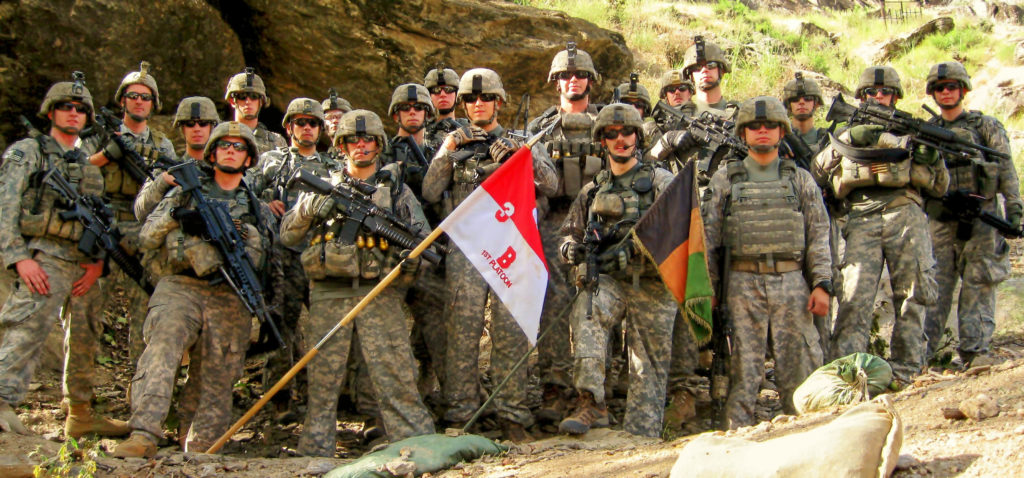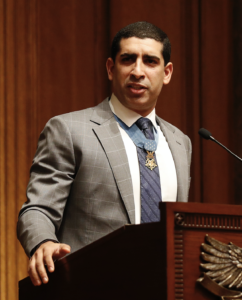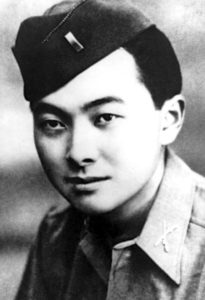On the morning of October 3, 2009, members of the U.S. Army’s Black Knight Troop (3-61 Cav, 4th Brigade Combat Team, 4th Infantry Division) were attacked at their base – Combat Outpost Keating – by more than 300 well-armed Taliban soldiers. Located deep within Afghanistan’s remote and mountainous Nuristan province, COP Keating was established in 2006 as a base of operations for U.S. Army personnel seeking to stop the flow of soldiers and munitions arriving from nearby Pakistan and as a place to direct and support counterinsurgency efforts in the nearby villages. The deadly attack on October 3 led to the deaths of 8 U.S. Army servicemen and wounded another 22. The remarkable courage and heroism shown during this desperate battle led to numerous decorations, including Medals of Honor for Staff Sergeant Clinton Romesha and Specialist Ty Carter.
Combat Outpost Keating
Since its creation in 2006, Combat Outpost Keating (COP Keating) was declared by almost every arriving U.S. soldier to be a terrible location for a base. With soaring mountains looming high above it, the base was vulnerable to fire from a multitude of positions on the rocky slopes above. Even worse, the rough road leading to the base – once used by armored Humvees and Afghan “jingle trucks” bringing supplies – was no longer used due to the persistent threat of ambush and the frequent washouts. All supplies now arrived by helicopter at night.
Deep within Afghanistan’s rugged Nuristan province, COP Keating was first considered a base from which U.S. Army counterinsurgency efforts could win local Afghan villagers’ hearts and minds through funded improvement projects. However, these counterinsurgency efforts had produced little long-term benefit as the villagers could not, or would not, stop the Taliban and other local warriors from moving through their towns and trails. Given its glaring defensive weaknesses and lack of a compelling mission, the Army had approved a plan to elimiate the base in August of 2009. Unfortunately, the evacuation plan was postponed due to a lack of available heavy-lift helicopters and simmering tensions between President Barack Obama and Afghan President Hamid Karzai, who was concerned that the U.S. president’s commitment to Afghanistan’s security was waning.
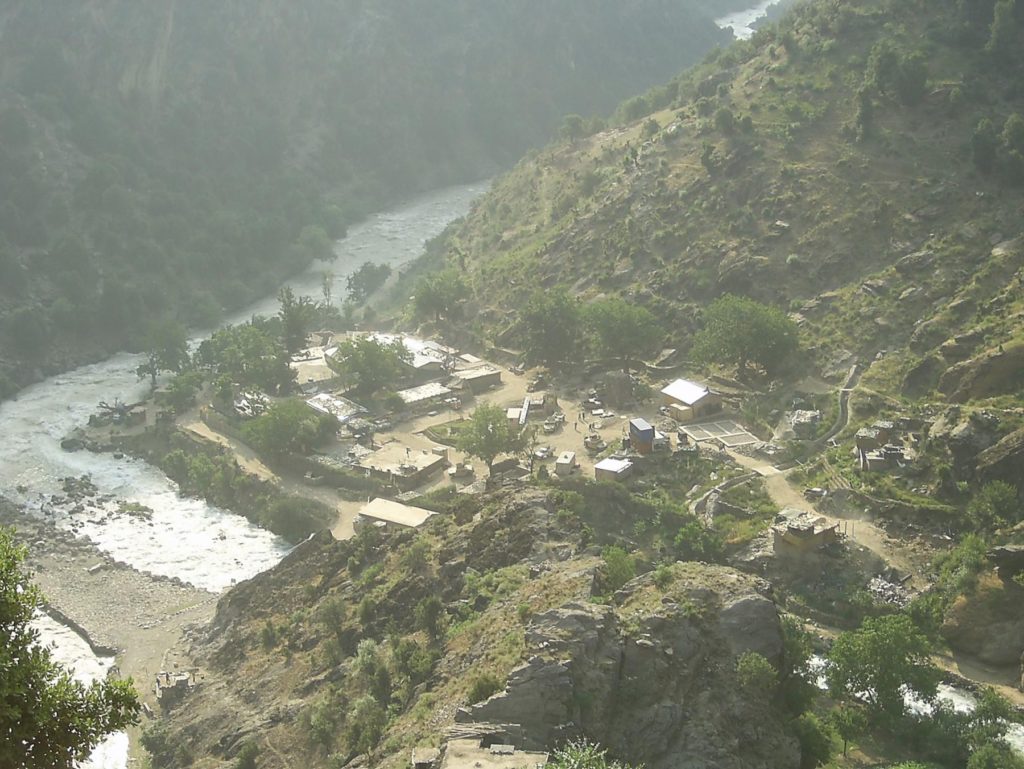
While every U.S. Army unit to occupy COP Keating had encountered regular sniper and mortar fire, the camp witnessed a significant escalation of attacks in 2009 – 212 different attacks in the first 9 months. The 48 U.S. Army and 24 Afghan National Army (ANA) forces assigned to the base in October had almost become accustomed to the regular attacks. And intelligence reports for the region dismissed fresh rumors of a pending major assault as a likely exaggeration.
The Taliban are here! They’re Coming!
After completing their morning prayers, close to 300 Taliban soldiers, led by Abdul Rahman, unleashed a torrent of fire from their mountain positions around the camp. B-10 recoilless rifles, Dushka heavy machine guns, rocket-propelled grenades, and mortar fire began to rain down on the camp at 5:58 am local time. With intimate knowledge of the camp’s layout, weapon systems, and the Army’s operational procedures, the Taliban first targeted the men near the camp’s most powerful weapon – its 120mm mortar. Soldiers manning the armored Humvees with turreted machine guns (LRAS-1 and LRAS-2) also received punishing fire. The men stationed at nearby Observation Post Fritsche were also attacked at this same time and were unable to provide supporting fire. At 6:03 am, the outpost’s command center sent out an urgent message over the mIRC network – “FRITSCHE AND KEATING IN HEAVY CONTACT.”
As the U.S. Army soldiers quickly roused from the barracks and donned their gear, the attack increased in intensity. Private First Class Kevin Thomson in the 120mm mortar pit was stuck in the face by a bullet and killed. Sergeant Josh Kirk, who had been preparing to fire an AT4 anti-tank rocket at the ‘Putting Green’ location, was mortally wounded by RPG shrapnel and a sniper’s bullet which struck him in the head. Those soldiers in and around the armored Humvees found it increasingly difficult to return fire as they were continually targeted and their ammunition ran low.
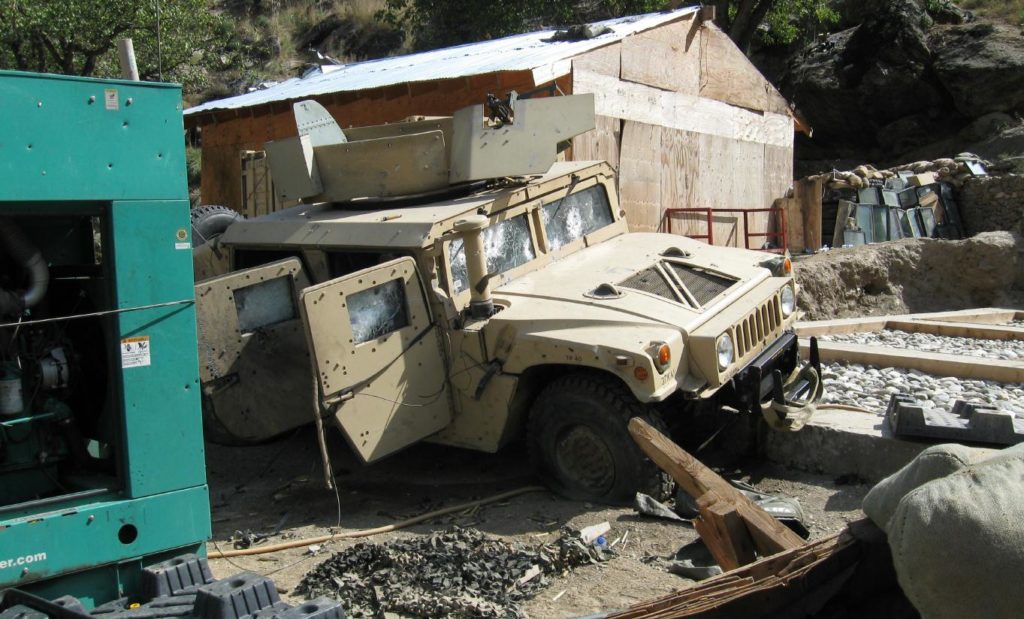
The men at LRAS-2 were busy firing their .50 cal. when an RPG round knocked the heavy machine gun off its mount and sprayed shrapnel into Sergeant Vernon Martin’s body. Meanwhile, Sergeant Justin Gallegos, firing his M240 machine gun near the Humvee, received fire and his gun was also put out of action. With no means of suppressing the heavy enemy fire, Gallegos and Specialist Stephen Mace got into the armored Humvee where Larson and the wounded Martin were. Specialist Ty Carter ran 75 yards through a shower of bullets to reach the Humvee with more M240 ammunition, but that gun was no longer operational. Without returning fire, the camp was vulnerable to being overwhelmed by the Taliban descending the switchbacks.
Specialist Michael Scusa, running towards LRAS-1, was struck in the neck by a sniper’s bullet and killed.
Staff Sergeant Clint Romesha, hoping to provide covering fire for the men trapped in the LRAS-2 Humvee, began firing an M48 machine gun against the many enemy positions directing fire at them. Despite eliminating several machine gun positions, Gallegos believed that the fire against the Humvee was still too much to risk a run. Wounded by RPG shrapnel and almost out of ammunition, Romesha realized that the plan to assist the men in the trapped Humvee had failed.
6:50 am: “We’ve got enemy in the wire!”
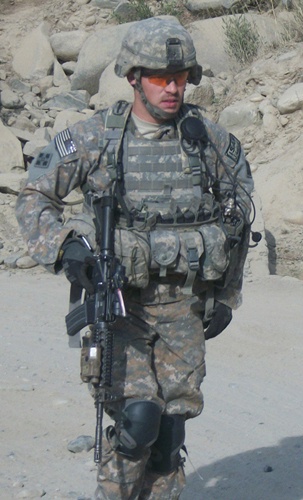
With casualties mounting and the enemy fire unrelenting, Romesha raced over to LRAS-1 to check on Specialist Zach Koppes trapped inside. Smoke and fire raged from the nearby ANA building and other structures.
While at LRAS-1, Romesha grabbed a Russian Dragunov sniper rifle and engaged in a cat and mouse duel with a Taliban sniper who had been targeting Koppes’ position. Dodging enemy shots and looking through the scope, Romesha silenced the sniper and gained Koppes more time.
Around this same time, as Taliban soldiers poured into the base, Specialist Chris Griffin and Joshua Hardt were killed. In Hardt’s case, his fellow soldiers would not learn of his demise until after the battle.
Meanwhile, Carter, Gallegos, Mace, Martin, and Larsen all sought to make their escape from the LRAS-2 Humvee. Hoping that a brief respite in the intense fire would give them a chance to escape, the men from the Humvee were met with an avalanche of machine gun and RPG fire once the Taliban saw the soldiers in the open. Mace’s legs were shredded by RPG shrapnel. And Gallegos, who had gone to Mace’s aid, was struck repeatedly and killed by the enemies’ fire.
The heavy enemy fire drove both Carter and Larson back to the relative safety of the riddled LRAS-2 Humvee. While Larson and Carter had found safety, the severely wounded Mace remained outside on the ground. Despite the persistent enemy fire, Carter finally convinced Larson to let him run over to Mace to provide aid. Applying an “Israeli bandage” and homemade splint to Mace’s shredded left leg, Carter located and treated other wounds with tape and gauze. Later, Larson and Carter placed Mace on a stretcher and raced him to the aid station as bullets rained down from above. Exhausted and in pain, Carter slumped to the ground outside the aid station.
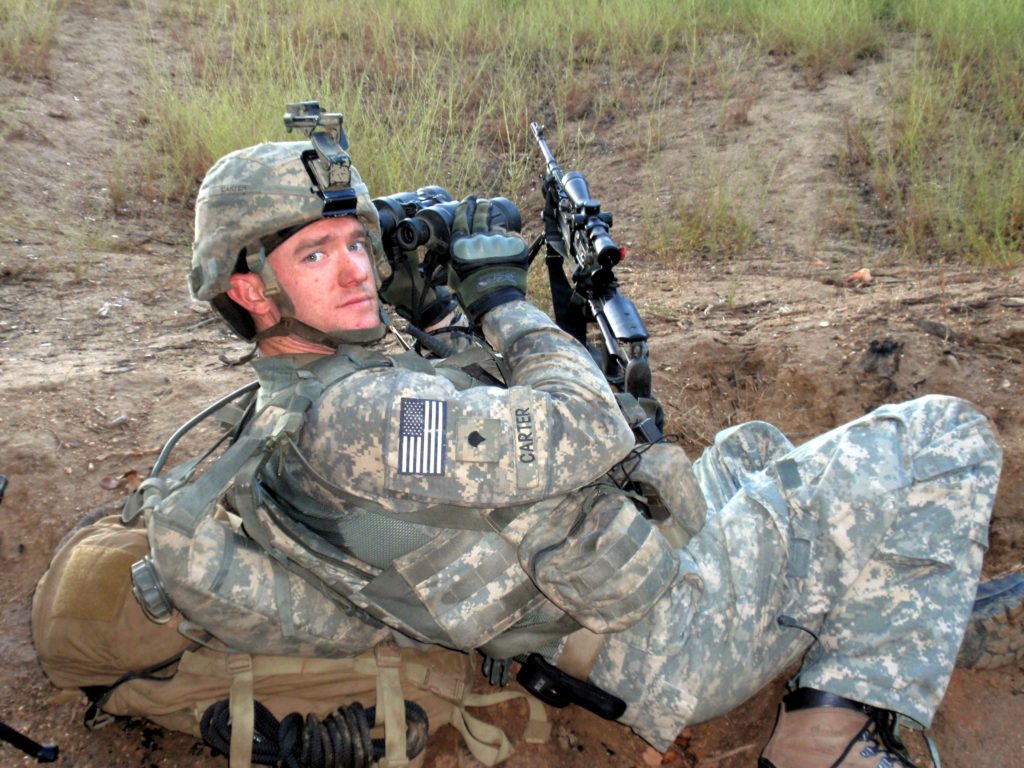
The Counterattack: “We’re Taking this Bitch Back”
With more and more Taliban soldiers now inside the base, an important decision was needed. The likelihood of being completely overrun was increasing rapidly. With ten or so unwounded soldiers available to counter the growing threat within the camp, Lt. Andrew Bundermann began to issue an “Alamo order” – a last-ditch, desperate shrinking of the perimeter to concentrate firepower. But Staff Sergeant Clint Romesha had a very different idea in mind. “[F] that….we need to retake this [f]ing camp and drive the [f]ing Taliban out!” After some discussion on the plan, Bundermann gave his approval, and Romesha rallied those willing to charge forward through the camp.
The counterattack plan included two coordinated actions. Sergeant First Class, Jonathan Hill from Blue Platoon (“The Bastards”), would take his men and focus on the eastern side of the camp – the ANA side. Romesha would concentrate on the western portion of the camp, aiming first for the ammunition storage shed and the entry point to the base.
Romesha made a passionate plea for volunteers to join him within the Red Platoon barracks. Thomas Rasmussen, Mark Dulaney, Josh Dannelley, Chris Jones, and Matthew Miller agreed to join him. To this brave crew, Romesha declared, “We’re taking this bitch back.”
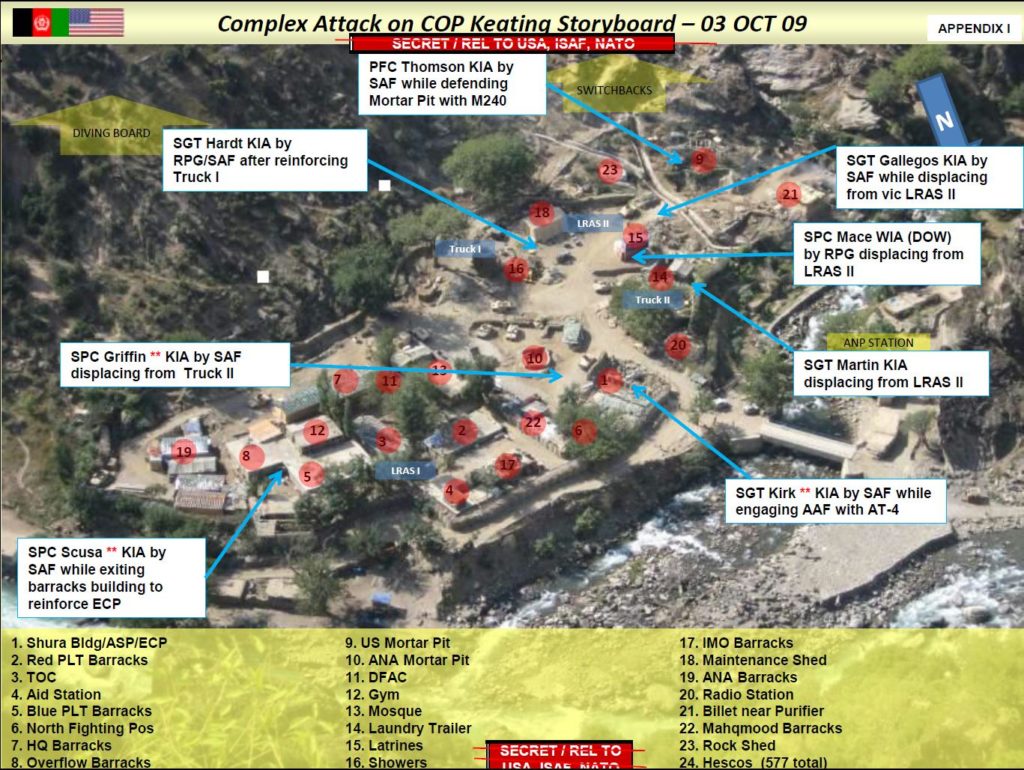
With newly arrived AH-64 Apache helicopters striking Taliban positions in the mountains, Romesha and his team moved forward. They successfully reached the ammo shed, where they grabbed more grenades for their next action. Making their way to the Shura building, the Red Platoon team, augmented by the two Latvian ANA advisors – First Sergeant Janis Lakis and Corporal Martins Dabolins – attacked a large concentration of enemy fighters milling about. It was eight men fighting dozens, if not hundreds of fighters.
Reaching the dining hall, the team could move no further, given the heavy counter fire. As the group began to fire on targets outside the camp near the bridge, Dannelly was wounded by a nearby Taliban soldier who fired an AK-47 round into his shoulder. After dispatching other enemy soldiers near the camp entrance, Romesha turned to those near him and asked, “You guys trust me, right?” “This could get bad.” With the team, Romesha stormed the Shura building and secured the entrance to the camp.
While Romesha’s force was retaking key parts of the camp, Lt. Bundermann continued to direct the various U.S. aircraft and helicopters sent to provide close air support. A veritable aerial armada would show up in the skies over COP Keating – F-15Es, A-10s, B-1s, and AH-64 Apaches. The supporting aircraft would deliver 16 tons worth of ordnance against the enemy positions this day.
With the air attacks beginning to drive the Taliban off, a new threat emerged – fire. With many buildings now in flames, one of the surviving buildings – the aid station filled with wounded – was in danger of being destroyed by a nearby burning tree. Carter, who had previously worked at a Home Depot, was recruited to take the tree down with a chainsaw. As Carter cut into the burning wood, the tree spun and fell on the nearby tactical operations center, caving in its roof.
With the camp now mostly secure and the Taliban in retreat from the hillsides, Romesha cracked open a Dr. Pepper with his comrades. At 1230pm members of the Quick Reaction Force (QRF) from 1-32 Infantry, led by Lieutenant Colonel Brad Brown, arrived by helicopter at Observation Post Fritsche and began to descend the hillside toward COP Keating. The men dispatched the remaining Taliban soldiers they encountered and passed an enormous number of enemy dead on the slopes. By 7:00 pm, the threat to the outpost had come to an end. Through the incredible courage and bravery of the men of the Black Knight Troop, the base and its soldiers were saved. Mace was quickly loaded aboard a medevac helicopter and raced to the medical facility at Camp Bostick, where he, unfortunately, succumbed to his wounds.
The toll from the battle was heavy. Eight U.S. Army soldiers were killed in action, and another 22 were wounded. Of the roughly 300 Taliban fighters who had attacked the camp that day, approximately 150 them lay dead at the end of the battle.
The QRF force and the remaining members of the Black Knight troop would evacuate COP Keating on October 6, and on the following day, a B-1 bomber would lay waste to the remains of this problematic site. COP Keating would be no more.
Thirty-seven Army Commendation Medals with “V” for valor devices, 27 Purple Hearts, 21 Bronze Stars, and 9 Silver Stars would be awarded to the U.S. Army soldiers who had fought at COP Keating fateful October day. Sgt. Justin Gallegos and 1LT Andrew Bunderman’s Silver Stars would later be upgraded to Distinguished Service Crosses. For two of the soldiers, a higher decoration awaited.
Clint Romesha and the Medal of Honor
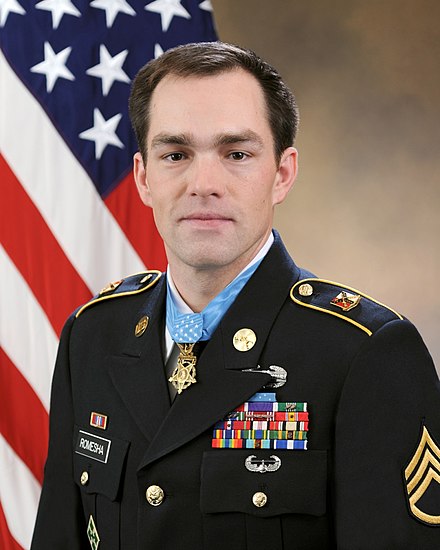
In January 2013, Clint Romesha, now a security specialist for an oil construction company in North Dakota, received a call from President Barack Obama. President Obama let Romesha know that he would be receiving the nation’s highest military decoration – The Medal of Honor.
In a White House ceremony on February 11, 2013, surviving members of the Black Knight Troop, the children of Gallegos and Kirk, the parents of Mace, and the widows of Scusa and Hardt, joined senior military members and President Obama for the awarding of the Medal of Honor. The president described the loving bond felt amongst the members of Romesha’s troop and then asked the crowd as to “what turned the tide that day?” Answering his question, President Obama spoke Clint Romesha’s own words – “We weren’t going to be beat that day…. You’re not going to back down in the face of adversity like that. We were just going to win, plain and simple.”
After the ceremony, Clint Romesha shared his conflicted feelings about receiving the Medal of Honor. Like so many other recipients before him, Romesha reflected on the terrible moments of October 3, 2009, and his lost comrades. Filled with emotion, he declared that the joy that came with the decoration was “countered by the constant reminder of the loss of our battle buddies, my battle buddies, my soldiers, my friends. I accept this tremendous honor on behalf of all soldiers who served with me that day.”
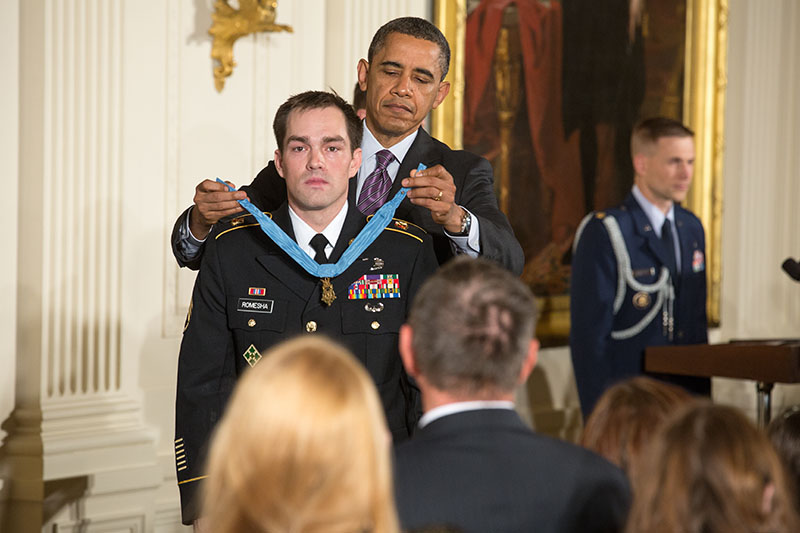
Citation
Staff Sergeant Clinton L. Romesha distinguished himself by acts of gallantry and intrepidity at the risk of his life above and beyond the call of duty while serving as a Section Leader with Bravo Troop, 3d Squadron, 61st Cavalry Regiment, 4th Brigade Combat Team, 4th Infantry Division, during combat operations against an armed enemy at Combat Outpost Keating, Kamdesh District, Nuristan Province, Afghanistan on October 3, 2009. On that morning, Staff Sergeant Romesha and his comrades awakened to an attack by an estimated 300 enemy fighters occupying the high ground on all four sides of the complex, employing concentrated fire from recoilless rifles, rocket-propelled grenades, anti-aircraft machine guns, mortars and small arms fire. Staff Sergeant Romesha moved uncovered under intense enemy fire to conduct a reconnaissance of the battlefield and seek reinforcements from the barracks before returning to action with the support of an assistant gunner. Staff Sergeant Romesha took out an enemy machine gun team and, while engaging a second, the generator he was using for cover was struck by a rocket-propelled grenade, inflicting him with shrapnel wounds. Undeterred by his injuries, Staff Sergeant Romesha continued to fight and upon the arrival of another soldier to aid him and the assistant gunner, he again rushed through the exposed avenue to assemble additional soldiers. Staff Sergeant Romesha then mobilized a five-man team and returned to the fight equipped with a sniper rifle. With complete disregard for his own safety, Staff Sergeant Romesha continually exposed himself to heavy enemy fire, as he moved confidently about the battlefield engaging and destroying multiple enemy targets, including three Taliban fighters who had breached the combat outpost’s perimeter. While orchestrating a successful plan to secure and reinforce key points of the battlefield, Staff Sergeant Romesha maintained radio communication with the tactical operations center. As the enemy forces attacked with even greater ferocity, unleashing a barrage of rocket-propelled grenades and recoilless rifle rounds, Staff Sergeant Romesha identified the point of attack and directed air support to destroy over 30 enemy fighters. After receiving reports that seriously injured Soldiers were at a distant battle position, Staff Sergeant Romesha and his team provided covering fire to allow the injured Soldiers to safely reach the aid station. Upon receipt of orders to proceed to the next objective, his team pushed forward 100 meters under overwhelming enemy fire to recover and prevent the enemy fighters from taking the bodies of their fallen comrades. Staff Sergeant Romesha’s heroic actions throughout the day-long battle were critical in suppressing an enemy that had far greater numbers. His extraordinary efforts gave Bravo Troop the opportunity to regroup, reorganize and prepare for the counterattack that allowed the Troop to account for its personnel and secure Combat Outpost Keating. Staff Sergeant Romesha’s discipline and extraordinary heroism above and beyond the call of duty reflect great credit upon himself, Bravo Troop, 3d Squadron, 61st Cavalry Regiment, 4th Brigade Combat Team, 4th Infantry Division and the United States Army.
Ty Carter and the Medal of Honor
Ty Carter had been promoted to staff sergeant and was stationed at Joint Base Lewis-McChord when he learned that he too would be receiving the Medal of Honor for his actions at COP Keating.
During the August 26, 2013, White House ceremony, President Obama not only highlighted Carter’s remarkable battlefield heroics, but also his courage in dealing with his ongoing post-traumatic challenges. Speaking to the crowd, but also to all soldiers coping with PTSD, Obama declared, “Look at this soldier. Look at this warrior. He’s as tough as they come. And if he can find the courage and strength, to not only seek help, but also to speak out about it, to take care of himself and to stay strong, then so can you. So can you.”
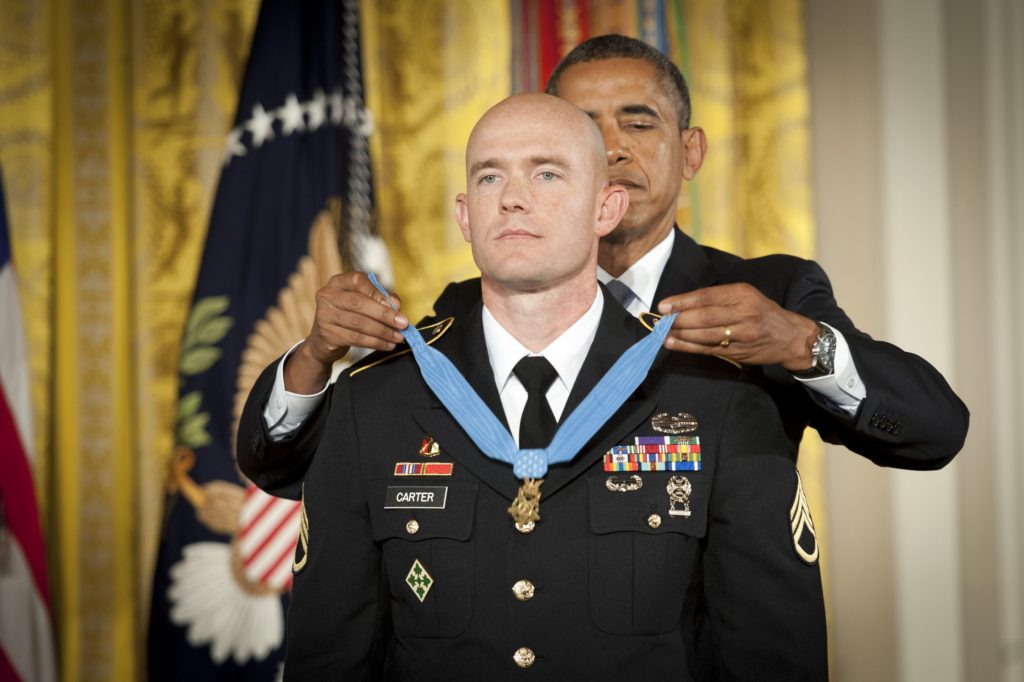
Citation
Specialist Ty M. Carter distinguished himself by acts of gallantry and intrepidity at the risk of his life above and beyond the call of duty while serving as a Scout with Bravo Troop, 3d Squadron, 61st Cavalry Regiment, 4th Brigade Combat Team, 4th Infantry Division, during combat operations against an armed enemy in Kamdesh District, Nuristan Province, Afghanistan on October 3, 2009. On that morning, Specialist Carter and his comrades awakened to an attack of an estimated 300 enemy fighters occupying the high ground on all four sides of Combat Outpost Keating, employing concentrated fire from recoilless rifles, rocket-propelled grenades, anti-aircraft machine guns, mortars and small arms fire. Specialist Carter reinforced a forward battle position, ran twice through a 100-meter gauntlet of enemy fire to resupply ammunition and voluntarily remained there to defend the isolated position. Armed with only an M4 carbine rifle, Specialist Carter placed accurate, deadly fire on the enemy, beating back the assault force and preventing the position from being overrun, over the course of several hours. With complete disregard for his own safety and in spite of his own wounds, he ran through a hail of enemy rocket-propelled grenade and machine gun fire to rescue a critically wounded comrade who had been pinned down in an exposed position. Specialist Carter rendered life extending first aid and carried the Soldier to cover. On his own initiative, Specialist Carter again maneuvered through enemy fire to check on a fallen Soldier and recovered the squad’s radio, which allowed them to coordinate their evacuation with fellow Soldiers. With teammates providing covering fire, Specialist Carter assisted in moving the wounded Soldier 100 meters through withering enemy fire to the aid station and before returning to the fight. Specialist Carter’s heroic actions and tactical skills were critical to the defense of Combat Outpost Keating, preventing the enemy from capturing the position and saving the lives of his fellow Soldiers. Specialist Ty M. Carter’s extraordinary heroism and selflessness above and beyond the call of duty are in keeping with the highest traditions of military service and reflect great credit upon himself, Bravo Troop, 3d Squadron, 61st Cavalry Regiment, 4th Brigade Combat Team, 4th Infantry Division and the United States Army.
Remembering the Fallen
U.S. Army soldiers killed in action at the October 3, 2009 Battle of COP Keating.
- Kevin Thomson (Reno, Nevada)
- Joshua Kirk (South Portland, Maine)
- Michael Scusa (Villas, New Jersey)
- Chris Griffin (Kincheloe, Michigan)
- Vernon Martin (Savannah, Georgia)
- Justin Gallegos (Tucson, Arizona)
- Joshua Hardt (Applegate, California)
- Stephan Mace (Lovettsville, Virginia)
Note: Many consider the 2010 death of Ed Faulkner, Jr., who had been suffering from PTSD, to be the ninth fallen soldier from the Battle of COP Keating.
Battle of COP Keating: Recommended Books and Movies
Movie: The Outpost
In 2020, a movie based on Jake Tapper’s book on COP Keating and the Battle of Kamdesh was released. Learn more about this movie.
Book: Red Platoon
Staff Sergeant Romesha, one of two Medal of Honor recipients from the battle, covers the Battle of COP Keating in vivid detail. Get Red Platoon: A True Story of American Valor by Clinton Romesha today
Book: The Outpost
Journalist Jake Tapper has written an authoritative history of the troubled history of Combat Outpost Keating and the Battle of COP Keating. Get the Outpost: An Untold Story of American Valor by Jake Tapper today
Links
The Battle for COP Keating (Military.com)
CENTCOM Report on the Battle of COP Keating
Podcast: The Spear – The Battle of COP Keating (USMA)
Video: The Battle of COP Keating
Battlescape: A Visual Representation of Staff Sgt. Romesha’s Heroic Actions
Battlescape: A Visual Representation of Staff Sgt. Carter’s Heroic Actions
The Fallen Heroes: 3-61 Cavalry (US Army)
Attacks on Remote Posts Highlight Afghan Risks (New York Times)
